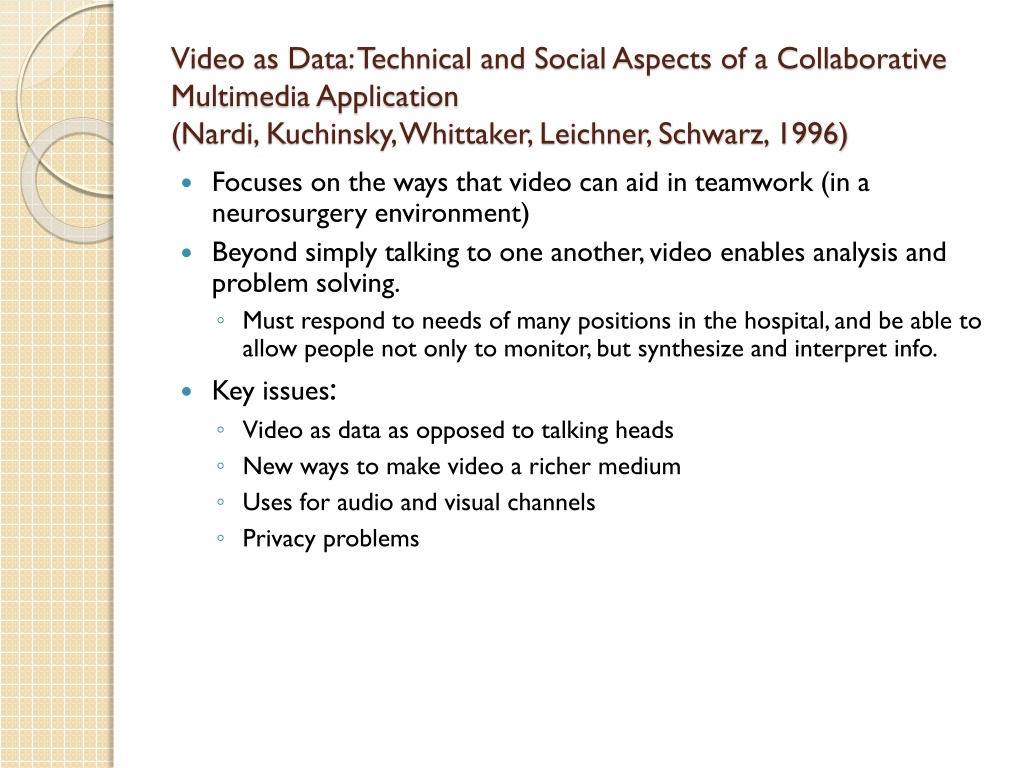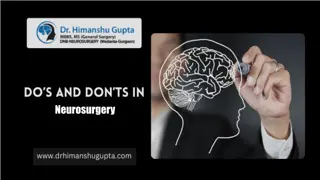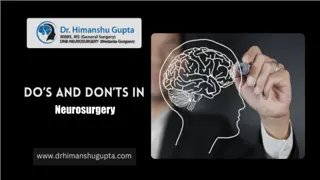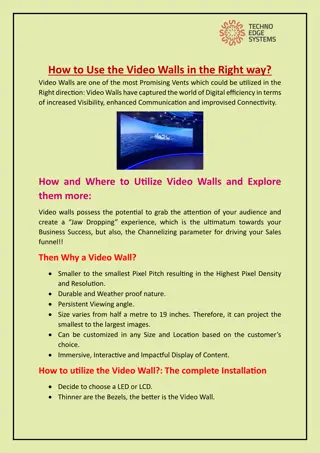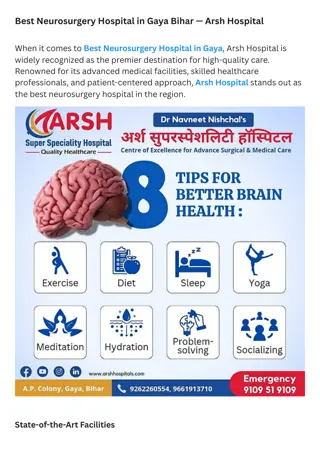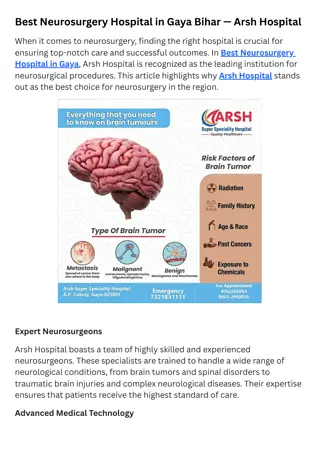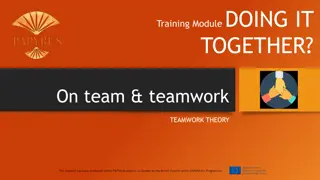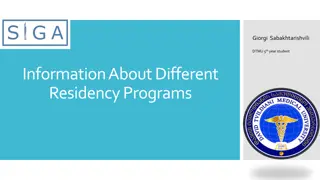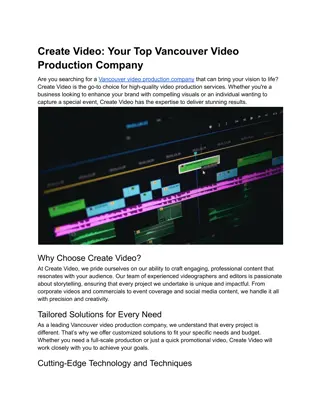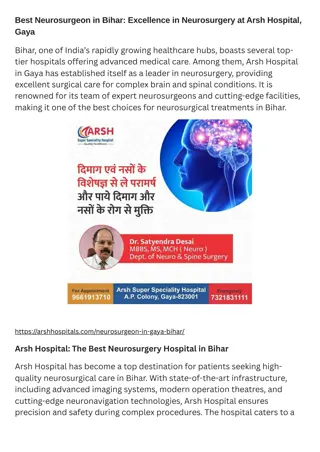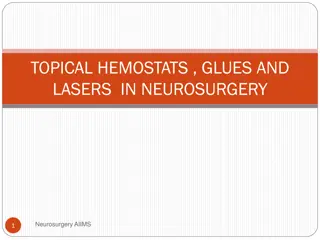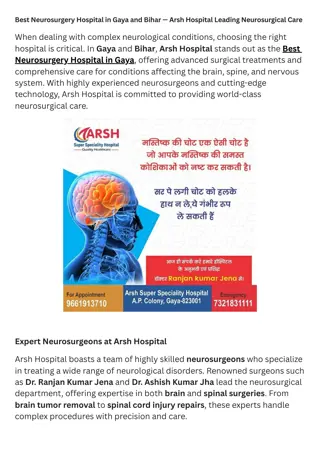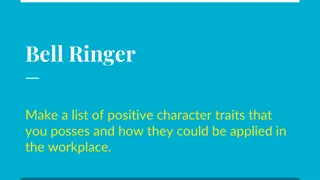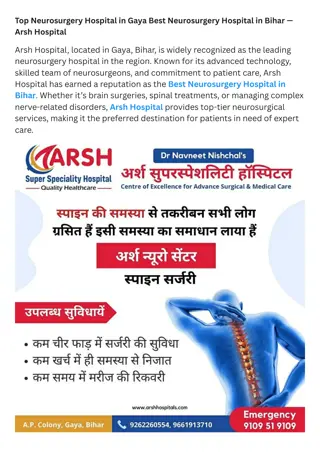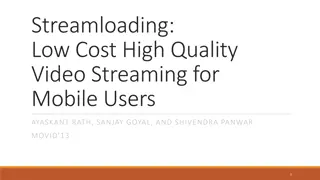Enhancing Teamwork in Neurosurgery Through Video Collaboration
Exploring the innovative use of video as data in a neurosurgery setting, this study discusses how live video feeds enrich collaboration by enabling analysis, problem-solving, and real-time coordination among diverse medical staff roles. The application of video technology goes beyond mere communication, offering insights into the challenges, benefits, and privacy concerns associated with incorporating video as a tool for enhancing teamwork in a hospital environment.
Download Presentation

Please find below an Image/Link to download the presentation.
The content on the website is provided AS IS for your information and personal use only. It may not be sold, licensed, or shared on other websites without obtaining consent from the author. Download presentation by click this link. If you encounter any issues during the download, it is possible that the publisher has removed the file from their server.
E N D
Presentation Transcript
Video as Data: Technical and Social Aspects of a Collaborative Multimedia Application (Nardi, Kuchinsky, Whittaker, Leichner, Schwarz, 1996) Focuses on the ways that video can aid in teamwork (in a neurosurgery environment) Beyond simply talking to one another, video enables analysis and problem solving. Must respond to needs of many positions in the hospital, and be able to allow people not only to monitor, but synthesize and interpret info. Key issues: Video as data as opposed to talking heads New ways to make video a richer medium Uses for audio and visual channels Privacy problems
Video as Data Goal of video-as-data is use (video) access to the environment/context to coordinate both teamwork and education among various staff. Scrub nurses use live video (of surgery) in room to coordinate and anticipate. Use of info crosses temporal lines Use of info supplements prior knowledge Anesthesiologist uses live video in room to keep interested Alleviates boredom, but the shared awareness is also useful for coordinating Neurophysiologist uses remote feed of data from the environment in concert with live video of surgery Allows them to oversee multiple surgeries, while multitasking Allows them to decipher data responses better when seeing video Multiple workspaces, serving highly varied, but collaborative functions.
Tools for video: Since video-as-data is so important, the tools for video must be updated. Augmentations, annotations, and parsing Specifically important for education: Synching up video of surgery with other (field specific) data sources, as was done in the hospital Practice and post hoc analysis Scrolling through data/video Finding particular data/video event Audio vs. Video: Each have their own purposes: What is said: Often, it s easier to hear via remote audio Aids in understanding and anticipation ( beyond being there ) Atmosphere/tone of OR The emotional tone of those in the room, and the surrounding noises change neurophysiologists behavior Remote video gave statistical/hard data, audio gave emotive/soft data Audio does more than just carry words, and video can do more than just display events (if we help it!)
Privacy (concerns with video use) With video comes an inherent REcontextualization of the events of the OR Calls into question lines between public/private behavior Changes the level of ephemerality Fear of changes in behavior Effects for collaborative process within the OR Fear of monitoring Big Brother and malpractice suits Annoyance at modes of introducing the technology Questions of who was informed, and cursory justification In many ways, this is the opposite of other video CMC (not useful, but enjoyable), in terms of they don t like it, but it s useful. Do the solutions aptly cover problems raised, or just paper over political/professional divide?
Visual Information as Conversational Resource in Collaborative Tasks (Kraut, Fussell, and Siegel, 2003) Focuses on the role of visual info in maintaining task awareness and in achieving mutual understanding Collaborative tasks focus on: Identifying target objects Describing actions to be performed on targets Confirming actions have been executed. These require coordination, and visual info does that in two ways
Situational Awareness: Defined as: Up to date mental models of the state of the task and others activities. Common Grounding: Gained by being members of the same group, through linguistic co-presence, or through physical co-presence. Visual information as similar form of presence, so if we give a worker a bike to fix, a visually- present (and situationally aware) helper should be able to aid in grounding and in performing physical tasks.
Experiment 1 (video vs. audio help) Attempt to see how visual information: Affects/aids mentoring tasks taking complex coordination (fixing the bike) Task performance = #of tasks, completion time, repair quality Access to an expert helped, better communication tools had no effect. Affects the conversation about the task Explicitness of worker s descriptions More explicit when no visual info available--and in describing their own state ( uh-huh ) Experts treated workers descriptions differently Value of helper s instructions More instruction when worker can be seen
Experiment 2 (video vs. audio vs. side-by-side) Task Performance Side by side = 25% faster Visual info received via video influenced dialogue, but didn t improve performance. Conversational Grounding - Side by side =more efficient (fewer utterances, less acknowledgement) Deixis Side by side had most. In video, there may have been major reasons there was a lack of deictic expressions Workers did use deictic expressions, but helpers did not (based on shared environment). Also had to negotiate what shared environment was.
Gutwin, C., and Greenberg S. (2001) A Descriptive Framework of Workspace Awareness for Real-Time Groupware. Computer Supported Cooperative Work, Kluwer Academic Press. Goals: Develop Framework for Workspace Awareness Support the design of groupware systems Hypothesize that enabling awareness will increase performance What is Workspace Awareness? Knowing what is going on Up-to-the-moment understanding of another person s interaction with a shared workspace. Perception-Action cycle: individuals constantly perceiving and interpreting information Why is Workspace Awareness Difficult in Groupware? Reduced availability of perceptual information Interactions are more limited and less informative Systems do not present the data that is available
Gutwin, C., and Greenberg S. (2001) A Descriptive Framework of Workspace Awareness for Real-Time Groupware. Computer Supported Cooperative Work, Kluwer Academic Press. Framework Part 1: Elements of W.A. Knowledge
Gutwin, C., and Greenberg S. (2001) A Descriptive Framework of Workspace Awareness for Real-Time Groupware. Computer Supported Cooperative Work, Kluwer Academic Press. Framework Part 2: Mechanisms to Maintain W.A. Consequential Communication Passive results of other people s bodily actions Feedthrough Intercepting feedback that others receive from the environment Intentional Communication Explicit conversation Monitoring of others conversation
Gutwin, C., and Greenberg S. (2001) A Descriptive Framework of Workspace Awareness for Real-Time Groupware. Computer Supported Cooperative Work, Kluwer Academic Press. Framework Part 3: How W.A. is used in Collaboration Three Primary Benefits Reduce Effort Increase Efficiency Reduce Errors
Gutwin, C., and Greenberg S. (2001) A Descriptive Framework of Workspace Awareness for Real-Time Groupware. Computer Supported Cooperative Work, Kluwer Academic Press. Applications for Interface Design Posits that understanding of W.A. can inform interface design. Situated Placement, Literal Presentation Radar View
Ranjan, A., Birnholtz, J. P., & Balakrishnan, R. (2007). Dynamic shared visual spaces: Experimenting with automatic camera control in a remote repair task. Proceedings of CHI 2007 (pp. 1177-1186). ACM Press. Overview: Recognizes Trade-off: Overview vs. Detail Passive vs. Active Develop and Test the effects of an automatic camera control system in worker-helper Lego construction task
Ranjan, A., Birnholtz, J. P., & Balakrishnan, R. (2007). Dynamic shared visual spaces: Experimenting with automatic camera control in a remote repair task. Proceedings of CHI 2007 (pp. 1177-1186). ACM Press. Study Design: Camera Static vs. Automatic
Ranjan, A., Birnholtz, J. P., & Balakrishnan, R. (2007). Dynamic shared visual spaces: Experimenting with automatic camera control in a remote repair task. Proceedings of CHI 2007 (pp. 1177-1186). ACM Press. Study Design: Task Complexity Low vs High
Ranjan, A., Birnholtz, J. P., & Balakrishnan, R. (2007). Dynamic shared visual spaces: Experimenting with automatic camera control in a remote repair task. Proceedings of CHI 2007 (pp. 1177-1186). ACM Press. Hypotheses: Participants in the Automatic Condition will: Work Faster (H1) Have Less errors (H2) Receive greater benefit for higher complexity (H3) Greater Satisfaction (H4), Value detailed views over awareness of the partner (H5) Communication structure will: Have less direct interaction with the camera (H6) Differing use of Dominant/non-dominant hands in different conditions (H7)
Ranjan, A., Birnholtz, J. P., & Balakrishnan, R. (2007). Dynamic shared visual spaces: Experimenting with automatic camera control in a remote repair task. Proceedings of CHI 2007 (pp. 1177-1186). ACM Press. Findings: No main effects for camera condition (fails H1) Interaction found between task complexity and camera condition on completion time (supports H3)
Ranjan, A., Birnholtz, J. P., & Balakrishnan, R. (2007). Dynamic shared visual spaces: Experimenting with automatic camera control in a remote repair task. Proceedings of CHI 2007 (pp. 1177-1186). ACM Press. Findings: Errors: Less hand movements per minute in Automatic condition (Supports H2) Perceived Performance: Indiv perceived better in automatic condition (H4) But pair performance not better Communication Process Helpers resorted to verbal description in wide view (H5) Less vertical movement in automatic (showing pieces to camera) (H6)
Ranjan, A., Birnholtz, J. P., & Balakrishnan, R. (2007). Dynamic shared visual spaces: Experimenting with automatic camera control in a remote repair task. Proceedings of CHI 2007 (pp. 1177-1186). ACM Press. Discussion: System has positive impact more effective in lexically complex tasks (Gergle) Source of benefits Looser coupling to the helper Less effort for both helper and worker Easy to learn Allows for adaptation
Erickson, T. and Kellogg, W.A. (2000) Social Translucence: An Approach to Designing Systems that Support Social Processes. ACM Transaction on Computer-Human Interaction, 7(1) 59-83 Socially Translucent Systems: Digital systems that support coherent behavior by making participant and their activities visible to one another Visibility (The Door) Awareness I know you re there Accountability I know you know I know you re there Constraints/Translucence (The Editing Room) Awareness I am aware of activity around me Accountability I can t be held accountable if I m not there Privacy Issues
Erickson, T. and Kellogg, W.A. (2000) Social Translucence: An Approach to Designing Systems that Support Social Processes. ACM Transaction on Computer-Human Interaction, 7(1) 59-83 Proposed System: Knowledge Communities: designed with from a social perspective to support the discovery, use and manipulation of knowledge. These need to support Conversation: Activity support: enable long running deep conversations amongst participants. Knowledge can be embedded in these conversations Conversation Visualization and Restructuring: Searchable and Navigable, increase access and awareness of conversations. Also add to structure of conversations Organization Knowledge Spaces: handle the tradeoff between privacy and visibility through semi- visibility.
Erickson, T. and Kellogg, W.A. (2000) Social Translucence: An Approach to Designing Systems that Support Social Processes. ACM Transaction on Computer-Human Interaction, 7(1) 59-83 Implementation of Visibility: Realist (Video), Mimetic (Graphical MUD), Abstract approachs (Babble) Abstract approach over a Realist or Mimetic approach Scales well Text is easy to produce and manipulate Persistence
Erickson, T. and Kellogg, W.A. (2000) Social Translucence: An Approach to Designing Systems that Support Social Processes. ACM Transaction on Computer-Human Interaction, 7(1) 59-83 Babble: Persistent text conversation Supports emergence of conversational norms (through visibility, awareness, and accountability)
Erickson, T. and Kellogg, W.A. (2000) Social Translucence: An Approach to Designing Systems that Support Social Processes. ACM Transaction on Computer-Human Interaction, 7(1) 59-83 Babble: Synchronous activity representation Social proxy Shows Size of audience Amount of activity
Erickson, T. and Kellogg, W.A. (2000) Social Translucence: An Approach to Designing Systems that Support Social Processes. ACM Transaction on Computer-Human Interaction, 7(1) 59-83 Issues: What should be visible? Private chats? Longitudinal view of conversation? How to support Coherence? Do social proxies support accountability for breaking norms through visibility? Different forms for different contexts? (lecture forms) Browsability? How do we support search for new users? Knowledge access within organizations?
